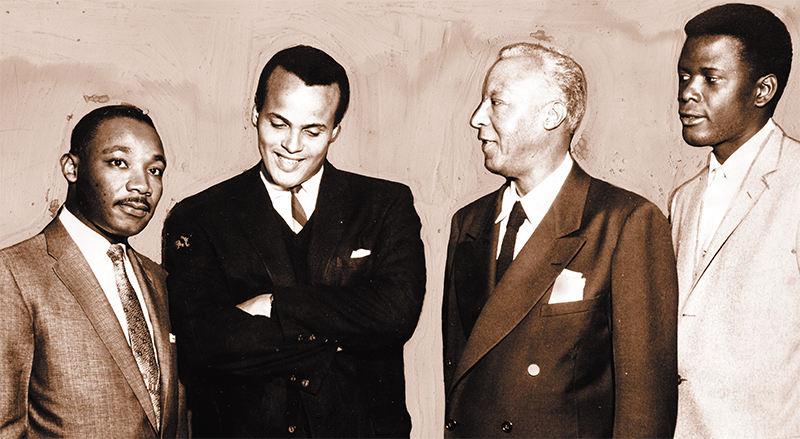Hampton Roads Community News
Harry and Sidney: Two Stately Gentlemen Who Made Us Proud

By Leonard E. Colvin
Chief Reporter
New Journal and Guide
This article was first written in 2019 as a tribute to two of America’s esteemed elder Black personalities whose lives were linked. At that time, Olivia de Havilland (103), Kirk Douglas (102) and Betty White, (97) were three of the most recognizable and oldest living Hollywood stars.
But conspicuously absent when the mainstream mentioned cinematic icons who have lived long lives were Harry Belafonte and Sidney Poitier.
In 2019, both were 92, born the same year just a month apart in February and March respectively. Recently, Belafonte passed at age 96 (Aprll 25, 2023); Poitier died on January 6, 2022 at age 94.
Both men started their career away from the silver screen. Belafonte started as an actor and was a famous singer. Poitier started on the stage and then drifted to the screen in the early 1950s until the late 1980s before becoming a noted director.
Apart from their contributions to the arts, both were ardent supporters of the Modern Civil Rights Movement.
During its most crucial period, notably in the early 1960s, they helped raise money for the cause and were close to one of its main leaders Dr. Martin Luther King, Jr.
Belafonte was born Harold George Bellanfanti Jr. at Lying-in Hospital in Harlem. His father was a white Dutch Jew and his mother was born of Black Jamaican and White Scottish parents.
From 1932 to 1940, he lived with one of his grandmothers in Jamaica. When he moved to New York City, after high school, he joined the Navy and served during World War II.
In the 1940s, Belafonte was working as a janitor’s assistant in NYC when a tenant gave him two tickets to see a performance at the American Negro Theater.
He fell in love with the art form and also met Poitier.
The pair were both financially struggling and often purchased one seat to plays and rotated their position in the theater, between acts, after informing the other about the progression of the play.
At the end of the 1940s, he took classes in acting at the Dramatic Workshop of The New School in New York alongside Marlon Brando, Bea Arthur, (Golden Girls fame) and Poitier. He and Poitier performed with the American Negro Theater.
Belafonte became an acclaimed Jamaican-American pop aka the “King of Calypso” for popularizing the Caribbean musical style with an international audience in the 1950s. His breakthrough album Calypso (1956) was the first million-selling LP by a single artist. Belafonte was perhaps best known for his recording of “The Banana Boat Song,” with its signature lyric “Day-O.” He also performed blues, folk, gospel, show tunes, and American standards.
He starred in several films, including Carmen Jones (1954), Island in the Sun (1957), and Robert Wise’s Odds Against Tomorrow (1959).
Belafonte was one of Martin Luther King Jr.’s confidants.
He was a UNICEF Goodwill Ambassador American Civil Liberties Union celebrity ambassador for juvenile justice issues.
Belafonte won three Grammy Awards, an Emmy Award, and a Tony Award. In 1989, he received the Kennedy Center Honors. He was awarded the National Medal of Arts in 1994. In 2014, he received the Jean Hersholt Humanitarian Award at the Academy’s 6th Annual Governors Awards.
***
Poitier, the youngest of seven surviving children, was born in Miami to Bahamian parents who were visiting the United States. His birth in America granted him automatic American citizenship.
At age 10, Poitier’s family moved to Nassau where he saw his first automobile, electricity, plumbing, refrigeration, and motion pictures
At 16, he moved to New York City and held a string of jobs as he learned to read the newspaper. In 1943, he enlisted in the Army during World War II.
He auditioned and joined the North American Negro Theater, but was rejected by audiences. He was unable to sing like his colleagues. On his second attempt at the theater, he was noticed and given a leading role in the Broadway production, Lysistrata.
By the end of 1949, he had to choose between leading roles on stage, but got his first movie role in the film “No Way Out” as a doctor treating a Caucasian bigot.
More roles arrived.
Poitier’s breakout role was as Gregory W. Miller, a member of an incorrigible high-school class in Blackboard Jungle (1955).
He was the first Black male actor to be nominated for a competitive Academy Award (for “The Defiant Ones,” 1958). He was also the first Black actor to win the Academy Award for Best Actor (for “Lilies of the Field” in 1963).
He acted in the first production of “A Raisin in the Sun” on Broadway in 1959, and the film version in 1961. In 1967, he was the most successful draw at the box office, the commercial peak of his career, with three popular films, “Guess Who’s Coming to Dinner;” and “To Sir, with Love.”
His character, Virgil Tibbs, a Philadelphia, Pa., detective in “In the Heat of the Night,” was the subject of two sequels: “They Call Me Mister Tibbs!” (1970) and “The Organization” (1971).
He received the 2001 Honorary Academy Award for his overall contribution to American cinema.
From 1997 to 2007, he served as the Bahamian Ambassador to Japan.
Poitier was knighted by Queen Elizabeth II in 1974. On August 12, 2009, Poitier was awarded the Presidential Medal of Freedom, the United States’ highest civilian honor, by President Barack Obama.
In 2016, he was awarded the BAFTA Fellowship for outstanding lifetime achievement in film. In 1999, the American Film Institute ranked Poitier 22nd of 25 on their list of Greatest Male Stars of classic Hollywood cinema.
In 2002, 38 years after receiving the Best Actor Award, Poitier was chosen by the Academy of Motion Picture Arts and Sciences to receive an Academy Honorary Award, in recognition of his “remarkable accomplishments as an artist and as a human being.”